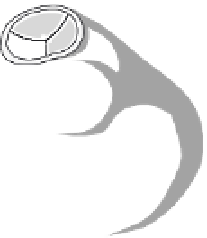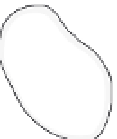Biomedical Engineering Reference
In-Depth Information
EXAMPLE PROBLEM 3.7
What would be the cardiac output of the heart in Example Problem 3.6 if the stroke volume is
75 ml?
Solution
The cardiac output (given in liters per minute) is the product of the heart rate and the stroke
volume.
84
beats
75
ml
6300
ml
3
liters
min
CO
¼
min
beat
¼
min
¼
6
:
During atrial and ventricular systole, special one-way valves (Figure 3.23a) keep the
blood moving in the correct direction. When the atria contract, the atrioventricular valves
(tricuspid and mitral) open to allow blood to pass into the ventricles. During ventricular
systole, the semilunar valves (aortic and pulmonary) open to allow blood to leave the heart,
while the atrioventricular valves close and prevent blood from flowing backward from the
ventricles to the atria. The aortic and pulmonary valves prevent blood from flowing back
from the pulmonary artery and aorta into the right and left ventricles, respectively. If a
valve becomes calcified or diseased or is not properly formed during embryonic develop-
ment, it can be replaced by an artificial valve (Figure 3.23b), a device that has been devel-
oped by cooperative work between biomedical engineers and physicians.
Blood pressure can be measured directly or indirectly (noninvasively). Direct blood
pressure measurements are made by introducing a catheter or needle that is coupled to a
pressure transducer into a vein or artery. Indirect methods include sphygmomanometry,
AORTIC
SEMILUNAR
VALVE
PULMONARY
SEMILUNAR
VALVE
LEFT
CORONARY
ARTERY
RIGHT
CORONARY
ARTERTY
TISSUE
FLOATING DISC
CAGED BALL
MITRAL
VALVE
TRICUSPID
VALVE
(a) (b)
FIGURE 3.23
(a) The atrioventricular (tricuspid and mitral) and semilunar (pulmonary and aortic) valves.
(b) Three types of artificial valves—tissue, floating disc, and caged ball—that can be used to replace diseased or
malformed human valves.












































































































































































































